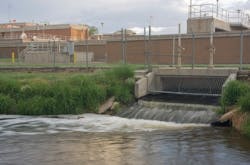By Thomas Kavookjian
Like many municipalities, Cinnaminson Sewerage Authority (CSA) faced challenges in improving its ability to meet discharge permit limits. CSA, located in Cinnaminson, NJ, is a 2 mgd designed plant with a daily average flow of 1.2 mgd. It is a conventional activated sludge process with a 2 million gallon equalization tank, six primary settling tanks, two sets of aeration tanks fitted with surface aerators, six secondary clarifiers (which includes a 13,000 gpd bypass back to the primary tanks), and a chlorine contact tank that discharges to the Delaware River.
CSA was experiencing pH issues and needed to add caustic soda to the system to maintain proper pH. This was accomplished with a sensor mounted in the plant flow stream which operated a metering valve that regulated the flow of caustic soda based on the pH levels. The authority was also adding polymers to the secondary clarifiers to improve settling.
After looking for alternative solutions to accomplish the same tasks with organic materials, CSA decided to add Biological Activity Enhancer (BAE)® to the system at the rate of one part per million or 1 gallon of BAE for every 1 mgd of plant flow. BAE is a peat humic substance manufactured by Prodex, a JSH International Company, which uses a patented extraction process that stabilizes these substances into an organic, liquid formula.
Wastewater treatment is a series of biochemical reactions created by a complex population of indigenous microorganisms that occur naturally under controlled conditions. The success of the process is dependent upon establishing a mixed community of microorganisms that will remove and consume organic waste material.
This task can become difficult at times because of the nature of the entering waste stream and the level of toxicity. Chemicals can be used to correct any disruption or ongoing challenges but also may disrupt the natural balance of the treatment system by deterring the growth of microbial cells such as ciliates, bacteria, fungi, and amoebas.
BAE spurs the growth and activity of these microbial cells, which over time can reduce the amount of total suspended solids (TSS) and biological oxygen demand (BOD) in secondary clarifier and plant effluent. It can also help bring the indigenous complex population of microorganisms back into balance.
Within 30 days of using BAE, CSA stopped using caustic soda and polymers and lowered the level of TSS and BOD from 30+ mg/l to 15 mg/l. This reduced the amount of suspended solids (SS) in the effluent entering the Delaware River by as much as 125 pounds per day, which means that approximately 45,000 pounds of SS were kept from entering the waterway annually.
Within the first six months of adding BAE, CSA began routine maintenance of its two aeration tanks. This involved shutting off one of the tanks and operating with just one aeration tank. During past maintenance periods the plant typically experienced BOD and TSS effluent levels that exceeded permit limits. However, in this instance use of BAE helped the facility lower BOD and TSS and maintain discharge permit levels during the aeration tank maintenance.
The added benefit of being able to operate with one aeration tank saved the authority about $31,600 annually. It is now common practice for the authority to operate with one tank for six months of the year, and they are still able to meet their discharge permit levels.
In one year, CSA saved more than $100,000 in operating costs by eliminating chemicals used in the system, removing one aeration tank from operation for six months and reducing sludge hauling from 1 MG per year to 700,000 gallons per year.
Conclusion
Many operators face challenges in funding equipment upgrades and are looking to add solutions to their facility's existing equipment to increase efficiency while reducing operating costs. Adding an organic solution to the existing engineered structure can aid in achieving these goals, while complementing a facility's environmental initiatives.
WW
About the Author: Thomas Kavookjian is Manager of Technical Services for Prodex, offering the Wastewater Treatment industry BAE, an organic technology that improves plant operational efficiency and methane gas production in anaerobic digesters. For more information, please visit www.prodexproducts.com.
More WaterWorld Current Issue Articles
More WaterWorld Archives Issue Articles





